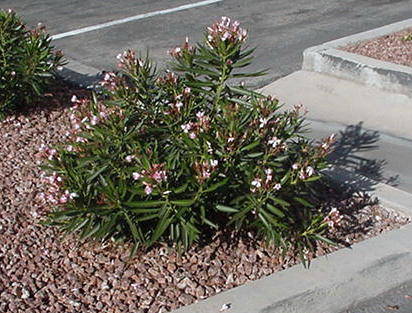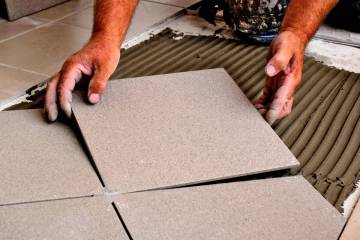Moapa publication lists vegetables suitable for valley growth
I was surprised when I was inundated with requests for my planting calendar and the Moapa vegetable publication written by Dr. Sylvan Wittwer. Dr. Wittwer grew vegetables there for nearly eight years after retirement as director of the Michigan State University Agricultural Experiment Station.
The Logandale and Moapa area is a few degrees warmer than Las Vegas but not as hot as Laughlin, Bullhead City or Lake Havasu City, which lie along the Colorado River. Those areas are closer to the Phoenix climate. The Moapa vegetable publication I sent would be appropriate for cultivating vegetables for all of the different elevations found in the Las Vegas Valley.
Q: My dwarf oleanders are growing too large for the space I provided. Is there a product I can use to ensure they don’t continue to grow larger?
A: There are products that slow the growth of plants, but I don’t like to recommend them because there are several problems using them. In some cases, they cause more problems than they fix if you do not know how to use them properly and manage the plant afterward.
In the case of oleanders, including your dwarf type, cut them nearly to the ground around mid-February and keep them smaller that way until pruning them again because they are getting too large. Prune them within 4 to 6 inches of the ground during the early spring months, and they will grow back fully in a couple of years. That is also the time you would remove any wild suckering from the base of the plant.
Not all shrubs can be pruned that way unless they show signs of suckering from their base.
Q: We moved to Las Vegas four years ago and had a professional landscape the backyard. We now have eight magnolias as well as peach trees throughout our backyard surrounded by large rock up against the trunks. This rock makes it difficult to fertilize the trees and pick the fruit. Our gardener told us the trees are not getting enough water. Should I pull the rocks away from the trunk of these trees and put wood mulch around their trunks?
A: First off, both peach trees and magnolias will not like the rock laid on the surface of the soil and surrounding the trees. You will see them start to suffer from this practice in three to five years.
Both prefer an organic mulch that can decompose into the soil and improve it. That means a 4-inch-deep layer of wood chips.
When buying peach trees, they should be on a semi-dwarfing rootstock such as Citation. If bought on this dwarfing rootstock, they can be planted about 10 feet apart and pruned to be kept small.
The soil should be enriched with a good quality compost at planting time and covered with 4 inches of wood chips, not rock. So yes, pull the rock back about 3 feet from the trunk and lay down 4 inches of wood chips instead.
Magnolias? Eight of them? Wow. I’m assuming you are talking about southern magnolia with its beautiful flowers. Even in Georgia, where they belong, one specimen tree is more than enough for a large yard.
Magnolias growing in Georgia can get 75 feet tall with a similar spread. These trees are not meant for backyard — or front yard — landscapes (desert or not) unless you have a huge property and water is cheap.
As these trees get older (if they do), they will become a nightmare to maintain and water. Get rid of them now before they get fully established. One tree is enough to satisfy your curiosity, and you will probably remove it in less than 10 years anyway.
Let’s say you keep the rocks. Using large rocks around plants has both pluses and minuses. If they are large enough, fertilizer or compost can be flushed on to the surface of the soil by washing it through the rock with a stream of water from a hose. Large rocks are also great for keeping people out.
But you are right. Large rocks make it difficult to harvest and prune fruit trees. In my opinion, rock larger than ⅜-inch diameter is difficult for walking safely.
Q: I have been looking for seeds for planting fall vegetables and herbs and not having much luck here in Las Vegas. Where should I start?
A: Start with varieties that have done well here in the past. Wittwer’s Moapa Valley vegetable growing publication is a good place to start. He mentions several older varieties that have performed well for him. I can forward a copy to you if you don’t have it.
Slowly introduce new varieties that have no production history in the desert. Be careful: Not all varieties produce well in a desert climate.
Consult online vegetable seed sources like Gurney’s, Park Seed Company, Territorial Seed Company, Baker Creek Seed and Grow Organic. Specialty seed sources like Kitazawa Seed and Seeds From Italy provide some interesting and heirloom seed sources.
Heirlooms don’t produce as much food as hybrids, but they are oftentimes tastier if you can get them to produce here.
Q: I have grubs in sections of my fescue lawn. They have been a problem in the past and they are again this summer. How do you prevent grubs from reinfesting a lawn each summer?
A: Make sure the brown areas you see is damage from grubs before you apply grub control products. Most brown spots on lawns during summer months are irrigation or disease-related, not from grubs. Usually, grub damage starts appearing early in the summer.
Brown spots from grub damage is probably the easiest to determine. In early summer, grab a handful of grass from the edge of a suspicious brown spot and lightly pull. If green grass is pulled up without roots on it, then your lawn probably has grubs.
YouTube videos will show infested grass rolling back like a carpet, but that’s only on sod-forming grasses like Kentucky bluegrass. We have mostly tall fescue in our lawns, which is a bunch grass. That makes identifying grub damage in our lawns different.
If you are convinced that brown spots are from grubs, then apply an insecticide for grub control to lawns in late spring. If you want to get a jump on controlling white grubs, apply the same insecticide to the lawn September through October.
Q: Does Ironite help Italian cypress if they are turning brown?
A: No. Ironite may help if the problem is an iron deficiency or the plants can’t take up enough iron. Iron problems on plants turn yellow first before they turn brown and die.
If the cause of the browning was from poor irrigation management and the soil staying too wet because of poor drainage, then Ironite will not do any good. The same is true for browning from spider mites.
By the way, Ironite only works if the soil is not too alkaline (pH above 7.6). Most of our desert soils are closer to 8.0 or higher. Mixing in lots of compost and adding water helps lower the soil pH close to the mid-7s. But if the soil has been covered in rock for a few years, then soil pH (alkalinity) will be close to 8 or above.
Q: We have four established Raywood ash trees on our small cul-de-sac. Three are doing fine, but the one directly in front of my condo is not. Just over the past few weeks, several brown dying branches have appeared. Our landscaper said all that was needed to be done was to trim the branches and give it more water. What are your thoughts?
A: Large dying branches in ash trees may be from a disease called ash decline. It can be from a lack of water, but if the tree doesn’t look much better after three weeks when larger amounts of water are applied, then it is probably ash decline disease. There is no cure for ash decline, and the tree should be replaced with a tree that is not an ash tree.
Plant diseases don’t happen all at once just like they don’t happen all at once with diseases in humans or animals. The reason you see it on one tree is that it may be just beginning. Eventually, if one tree has it, they will all get it — whether that is in 10 years or 15 years, I don’t know. Keep an eye on the others. Remove infected trees early.
Bob Morris is a horticulture expert and professor emeritus of the University of Nevada, Las Vegas. Visit his blog at xtremehorticulture.blogspot.com. Send questions to Extremehort@aol.com.





























